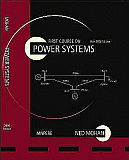Professor De Boer's list of
TEXTBOOK ERRATA
(last update 10/27/2011)

Ned Mohan,
First Course on Power Systems, 2006 Ed., MNPERE, 2006.
ISBN 0-9715292-7-2
Page 2-20. Fourth line from the top of the page
There is a sign error.
Change, "ZL = 1.25/–36.87°
pu" to
"ZL =
1.25/36.87° pu"
Page 2-32. Problem 2-16
Change, ". . . from side 1 to side 2."
to, ". . . from the V̅S source to the
V̅R source."
Page 2-32. Problem 2-17
"Load" and "source" and VR and
VS are interchanged in a few
places and a unit (V) is missing.
A corrected version of the problem statement is:
In a radial system represented by the circuit of Fig. 2-17a,This problem is supposed to show that loads with low or even slightly leading power factors can be used to help maintain or even raise the voltage at the load. Conversely, even slightly lagging power factors can cause voltage sag.
X = 1.5. Consider the source voltage to be constant at VS = 100∠0º V. Calculate and plot |VR|/|VS| if the load varies in a range from 0 to 1 kW a the following three power factors: unity, 0.9 (lagging), 0.9 (leading).
(posted 10/06/2009. Updated 10/08/2009 This errata has been corrected in some printings of the text.)
Page 2-32. Problems 2-18 and 2-20
Change the phrase, ". . .base 2-phase power. . ."
to, ". . .base three-phase power. . ." everywhere it occurs.
Page 4-12. Text just above Equation 4-30
Change, "where Zc is the surge impedance
to, "where Zc is the characteristic impedance"
(The term Surge Impedance is usually reserved for caluclations of Zc that assume a lossless line, that is, R = 0 and G = 0. The discussion at the top of page 4-13 is intended to make this point.) (Posted 10/22/2009)
Page 4-13. Text just above Equation 4-35
Change, "impedance Zc, also called the surge
impedance. . ."
to, "impedance Zc, is given the special name
surge impedance. . ."
(Posted 10/22/2009)
Page 4-16. Equation 4-44
Change the "2" in the denominator to "Zc"
The corrected equation is:
(Posted 10/28/2009)
Page 4-21. Problem 4-12
The problem is unworkable as given.
Replace the problem statement with this:
In a 20 km long cable system the nominal line-to-line voltage
is 230 kV. The system is operated with the receiving end
voltage, Vr, at 1∠0° p.u. (V)
and the sending end voltage, Vs is
1∠10° p.u. (V). The cable has a surge impeadence of
25 Ω if resistance and shunt conductance are neglected.
It has actual resistance of 0.05 Ω/km per phase
conductor and three-phase reactive charging power of
14.5 MVA/km when operated at nominal voltage.
Calculate:
a.) The power delivered to the load at the receiving end.
b.) The power loss in the cable.
c.) The power supplied to the cable at the source end.
d.) The efficiency of the cable (power delivered to the load
versus power input to the cable at the source end.)
Page 5-2. Text 12 lines from the top of the page
Change the word "modal" to "model"
(Posted 10/28/2009)
Page 5-2. Text on last two lines of the page
Delete the words "specified" in the first instance and
delete the word "also". The corrected lines read:
"4. There are buses where there is no P and Q
injection, and the voltage
is not specified. Often, these become necessary for
including transformers."
(Posted 10/28/2009)
Disclaimer: This list of errata is provided by Professor De Boer for the use of his students in his courses. Professor De Boer has no connection to the book's publisher or the authors of the textbook. This list is offered as is, with no guarantee of any kind. (This list is likely to be incomplete at the least.)
Back to Prof. De Boer's home page